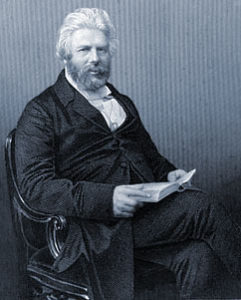 Dinosaurs found in unexpected places. In 1933, the Sinclair Oil Corporation sponsored an exhibit at the World’s Fair in Chicago. The Earth’s oil reserves, it was thought, formed during the era of the dinosaurs–the Mesozoic Era.
Dinosaurs found in unexpected places. In 1933, the Sinclair Oil Corporation sponsored an exhibit at the World’s Fair in Chicago. The Earth’s oil reserves, it was thought, formed during the era of the dinosaurs–the Mesozoic Era.
The exhibit was so popular, a silhouette of a green dinosaur, a Brontosaurus, became Sinclair’s official logo (pictured left). Gaining popularity a few decades later, at the New York World’s Fair in 1964, Sinclair introduced their expanded exhibit, called Dinoland, featuring life-size replicas of nine different dinosaurs, including their signature 27-foot tall and 70-foot long Brontosaurus. Admission was free.
The exhibit re-enacted the once-popular dinosaur oil production theory along with erupting volcanos, flashing lightning, and bubbling streams. Now, more than a half-century later, dinosaurs found in unexpected places give new insights into the Earth’s massive flooding and plate tectonic events.
First Discovery
The first reported fossil record discovery of a dinosaur bone in modern times was in a limestone quarry at Cornwell, England (pictured left) in 1676 – a Megalosaurus, meaning a “Great Lizard” in Greek. The discovery was reported the following year in the Natural History of Oxfordshire – long before Darwin.
Second Discovery
William Buckland discovered the second documented dinosaur in the 1800s in a limestone quarry. Since then, dinosaurs have been discovered on all seven continents, including Africa, Antarctica, Asia, Australia, Europe, and North and South America.
Dinosaur Name
In 1842, Richard Owen of the British Museum of Natural History coined the name for this new reptile class. The name “dinosaur” is from the Greek words deinos, meaning terrifying, and sauros, meaning reptile. Fascination with these terrifying monsters triggered a stir.
Just two years later, in 1844, Robert Chambers (pictured left) anonymously published the book entitled Vestiges of the Natural History of Creation. With 33 references to dinosaurs, Chambers argued for transmutation.
Dinosaur Sensation
Chambers avoided using the term “evolution” in the book since it had become a highly charged word, even then. Nevertheless, the book became the first to cohesively link dinosaurs with the newest theory of geology known as uniformitarianism in association with transmutation, best known today as evolution. The book became a sensational bestseller.
Even Queen Victoria is reported to have read and become fascinated with the book. Sales of Chamber’s book far exceeded The Origin of Species through the 1880s. Interestingly, of the over 8,000 specimens Darwin sent back to England during his 5-year voyage, not a single one has yet been identified as a dinosaur. Even so, dinosaurs have since emerged as a popular symbol of evolution.
The recent discovery of dinosaurs in unexpected places, ironically, however, is uncovering new, unexpected questions.
Unexpected Places
Land-walking (terrestrial) animals are not expected to be found fossilized in the ocean for one apparent reason – that’s neither where they lived nor expected to die. However, terrestrial dinosaurs have now been discovered in marine sediments in Africa, Asia, Canada, Japan, Russia, North America, and even in the North Sea. In the words of Nick Longrich of the University of Bath in the UK –
“A dinosaur [extracted] from marine rocks – it’s a bit like hunting for fossil whales and finding a fossil lion.”
North Sea
 In 1997, the first fossilized dinosaur ever to be reported in marine sediment was found in the North Sea. At nearly 8,000 feet (1.5 miles) below the 1,000-foot sea depth of the Snorre Oil Field (pictured left) off the coast of Norway, geologists spotted an unexpected curiosity in their core sample.
In 1997, the first fossilized dinosaur ever to be reported in marine sediment was found in the North Sea. At nearly 8,000 feet (1.5 miles) below the 1,000-foot sea depth of the Snorre Oil Field (pictured left) off the coast of Norway, geologists spotted an unexpected curiosity in their core sample.
Within the drill bit was, what appeared to be, a crushed bone. However, they were persuaded by their crew, thinking it was just a plant, to store it away. The North Sea is thought to have once been a huge terrestrial area where rivers meandered through dry plains.
Fortunately, the core sample was saved.
In 2003, for unknown reasons, the specimen was sent to Jorn Harald Hurum (pictured right), a paleontologist at the University of Oslo, since it looked like it might be a crushed fossilized dinosaur bone. Astonished, Hurum told the BBC –
“It’s the first time a dinosaur bone has ever been found in such a deep core.”
“To drill through a terrestrial animal,” Hurum further explained, “is much rarer because there are so many more marine sediments there.”
A dinosaur found in an unexpected place… or, so it seems, without a massive flooding and plate tectonic event.
Russia
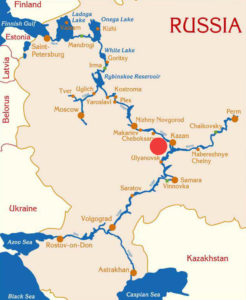 In the early 1980s, what looked like three giant bones along the banks of the Volga River (pictured left) in western Russia, had fallen from a towering limestone cliff near the village of Slantsevy Rudnik. Eventually, more of the cliff continued to slide off onto the riverbanks below.
In the early 1980s, what looked like three giant bones along the banks of the Volga River (pictured left) in western Russia, had fallen from a towering limestone cliff near the village of Slantsevy Rudnik. Eventually, more of the cliff continued to slide off onto the riverbanks below.
Vladimir Efimov, the head of the Undorovsky Paleontology Museum at the time, called the finds a “great vertebrate,” but he could not classify the fossils. In 1997, Efimov published his findings in the Paleontological Journal.
From the seven vertebrae that were eventually collected, the specimen was named Volgatitan simbirskiensis (pictured right), after the river (Volgatus means “common” in Latin). Volgatitan, however, was anything but common. This enormous, long-necked terrestrial sauropod walked the Earth, weighing nearly 40,000 pounds.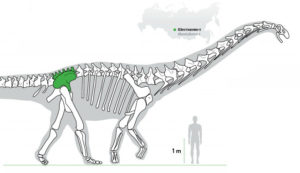
The fossilized bones, all but forgotten, sat for nearly 20 years until Alexander Averianov of the Russian Academy of Sciences decided it was time to re-examine Russia’s collection of dinosaurs. “I decided to also study the fossils reported by Efimov,” Averianov explained, “and visited his museum in July 2017 and examined the fossils.”
His investigation revealed that this fossilized land-walking dinosaur had been encased in marine sediment. As Averianov explained to Fox News, the fossils had come –
“from a cliff of marine sediments which are rich in invertebrate fossils such as ammonite and bones [of] marine reptiles.”
The elevation of this region, however, is over 1,000 feet – and thousands of miles from any ocean.
A dinosaur found in an unexpected place… or, so it seems, without a massive flooding and plate tectonic event.
Africa
 Beginning in the late twentieth century, the search for dinosaurs in Africa has uncovered more than 75 fossilized dinosaur species.
Beginning in the late twentieth century, the search for dinosaurs in Africa has uncovered more than 75 fossilized dinosaur species.
In 2017, the discovery of a probable terrestrial dinosaur in a Moroccan mine operated by Sidi Chennane drew the attention of paleontologist Nick Longrich. Importantly, the mine is known to be rich in phosphates and marine fossils – an unexpected place.
In the Kem Kem Beds of the Oulad Abdoun Basin (pictured left) on the far eastern border of Morocco, the mine is located thousands of miles from either the Atlantic Ocean and the Mediterranean Sea.
In collaboration with his colleagues based in Morocco, France, and Spain, Longrich identified the fossil as a new Abelisauridae species (pictured right). While similar to T. rex, this two-legged Chenanisaurus had 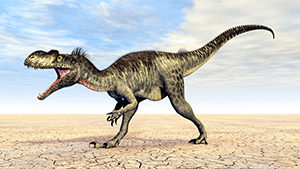 a shorter, blunter snout and even tinier arms.
a shorter, blunter snout and even tinier arms.
The Abelisauridae family is thought to have roamed the northern and southern hemispheres, including Asia, Australia, and North and South America. The team named the fossil Chenanisaurus barbaricus in honor of the mine “Sidi Chennane” where it was discovered, followed by barbaricus from the root word “barbaric.”
In 2019, the final report, “An abelisaurid (Dinosauria: Theropoda) ilium from the Upper Cretaceous (Cenomanian) of the Kem Kem Beds, Morocco,” was published in the online journal PlosOne. As Longrich explained to ScienceDaily –
“This find was unusual because it’s a dinosaur from marine rocks.”
A dinosaur found in an unexpected place… or, so it seems, without a massive flooding and plate tectonic event.
Japan
Excavations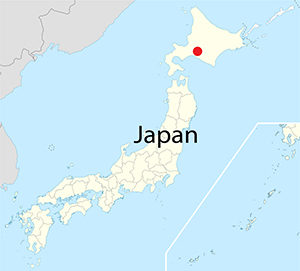 to extract a 25-foot-long fossilized duck-billed dinosaur began in 2013. The nearly complete skeleton is the largest dinosaur skeleton ever found in Japan (pictured left). Nicknamed “Mukawaryu,” meaning Mukawa dragon, the fossil was named in honor of the local town – an unexpected place.
to extract a 25-foot-long fossilized duck-billed dinosaur began in 2013. The nearly complete skeleton is the largest dinosaur skeleton ever found in Japan (pictured left). Nicknamed “Mukawaryu,” meaning Mukawa dragon, the fossil was named in honor of the local town – an unexpected place.
The range of this terrestrial dinosaur is thought to have once included Asia, Europe, North and South America, and even Antarctica. According to the research team from Hokkaido University and Hobetsu Museum in Mukawa, this fossil is actually the third complete skeleton of a Hadrosaurid (pictured right) to have ever been discovered in marine sediment.
Research team leader Yoshitsugu Kobayashi, professor of paleontology at Hokkaido University, in the final report published in the journal of Nature, September 2019, said of 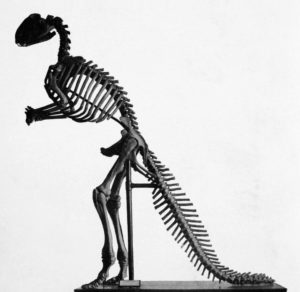 the unexpected finding –
the unexpected finding –
“Hadrosaurid materials from marine deposits are rarely reported.”
The Science News staff writer concurs,
“it is rare for a complete skeleton of a terrestrial dinosaur to be discovered in a marine stratum.”
During the mid-nineteenth century, the first of the three known Hadrosaurids was discovered by Joseph Leidy in New Jersey. Twenty years later, the second one was discovered on the property of John E. Hopkins in marine sediments east of Philadelphia across the Delaware River.
While the sediments for these areas are known to be rich in marine fossils, these two Hadrosaurids are now only known in the pages of history. It had been reported –
“Mr. Hopkins being young at the time of the discovery, and not especially interested in such subjects had permitted visitors to carry away the fossils.”
The current fate of Leidy’s Hadrosaurid, however, may yet be found in Philadelphia’s Academy of Natural Sciences, where it was last known to be on display in 1868.
Intrigued with Hadrosaurids, in 2006, paleontologist Albert Prieto−Márquez (pictured right), of Florida State University investigated these two earlier discoveries further. Concluding that they were indeed discovered in marine sediments. In his published report, Prieto−Márquez could appreciate why Leidy once said that he –
“regarded it as most probably an amphibious animal.”
A dinosaur found in an unexpected place… or, so it seems, without a massive flooding and plate tectonic event.
Canada
 Nestled within the vast 540,000 square miles of the Western Canadian Sedimentary Basin in the providence of Alberta, a stunningly well-preserved dinosaur was discovered just north of Fort McMurray. Boreal forests surround this town at the confluence (pictured left) of the Athabasca River and Clear Water River, which sits at an elevation of 1,000 feet.
Nestled within the vast 540,000 square miles of the Western Canadian Sedimentary Basin in the providence of Alberta, a stunningly well-preserved dinosaur was discovered just north of Fort McMurray. Boreal forests surround this town at the confluence (pictured left) of the Athabasca River and Clear Water River, which sits at an elevation of 1,000 feet.
It was early in the afternoon of March 2011, as oil sand heavy equipment operator, Shawn Funk, was working his way through the mine for Suncor when he spotted an unexpected lump in his shovel-load that had an odd yet distinct, diamond-like pattern.
As Suncor had trained their operators, Funk immediately shut down his enormous workhorse. Together with his supervisor, Michel Gratton, they immediately sent photos of their findings to the Royal Tyrrell Museum in Drumheller, Alberta.
The paleontologist at the museum, Caleb Brown, noted –
“This [dinosaur] is truly remarkable in that it is completely covered in preserved scaly skin, yet is also preserved in three dimensions, retaining the original shape of the animal,”
“The result is,” Brown continued, “that the animal looks almost the same today as it did back in the Early Cretaceous epoch … It will go down in science history as one of the most beautiful and best-preserved dinosaur specimens — the Mona Lisa of dinosaurs.”
With no known relatives, the fossil has since been named Borealopelta markmitchelli (pictured right). “Borealopelta” means “northern shield” and “markmitchelli” to recognize museum technician Mark Mitchell, for his five-year commitment to the project.
Dubbed the “four-legged tank” with two 20-inch long spikes protruding from the shoulders, Daniel Uria explained the “body was submerged at the bottom of the sea,” writing for UPI news. How a terrestrial monster could have ended up at the bottom of the sea emerged again as an unexpected and unpredicted finding.
In looking for an explanation for this apparent conundrum, Donald Henderson, the museum curator, in an interview with Blake de Pastino, who was writing for Western Digs, said –
“Finding the remains of an armored dinosaur that was washed far out to sea was a huge surprise.”
Science writer Ed Yong, writing for The Atlantic, speculating on how this could have happened, said –
“Somehow, this particular individual ended up at sea. Perhaps it got careless on a shoreline. Perhaps it drowned in a flood and was washed out to sea.”
Weighing in further, Michael Greshko, science writer for National Geographic, advanced essentially the same theory –
“This armored plant-eater lumbered through what is now western Canada until a flooded river swept it into the open sea.”
After speaking with the museum paleontologists, Cecile Borkhataria and Tim Collins, writing for Britain’s popular Daily Mail, sided with a flood theory –
“The researchers believe that the dinosaur lumbered through what is now western Canada until a flooded river swept it into the open sea.”
A dinosaur found in an unexpected place… or, so it seems, without a massive flooding and plate tectonic event.
New Insights
While marine dinosaurs would be expected to be found in marine sediments, a scientific consensus for a natural mechanism for terrestrial dinosaurs ending up in marine sediments remains unknown. By definition, a valid scientific theory must result in a predictable outcome. Therefore, either there must have been errors in the evidence observed, or there is an error in the theory.
 Prussian astronomer Nicholas Copernicus (1473-1543) (pictured left) was confronted with a similar conundrum in the sixteenth century – his observations were incompatible with the reigning theory known as the geocentric model of the universe.
Prussian astronomer Nicholas Copernicus (1473-1543) (pictured left) was confronted with a similar conundrum in the sixteenth century – his observations were incompatible with the reigning theory known as the geocentric model of the universe.
Geology is the science that explores the history of the Earth. For Darwin, geology played an essential role in developing his theory. As recorded in his Autobiography –
“investigation of the geology of all the places visited was far more important [than its natural history]”
Darwin had become an advocate of the popular theory of geology developed by the then leading geologist Charles Lyell (1797–1875) (pictured right) president of the Geological Society of London. The theory is summarized in the following phrase –
“The present is key to the past”
Since Lyell’s theory of geology drove Darwin’s view of natural history, what scientific evidence validates Lyell’s “the present is key to the past” theory. Perhaps the conclusion “dinosaurs found in unexpected places” is wrong.
Geology Driven Biology
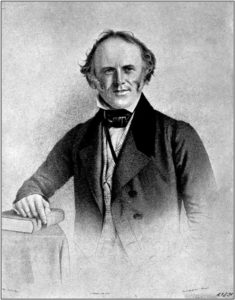 This concept – “the present is key to the past” – was popularized by Lyell in his book entitled the Principles of Geology. The first edition, published in 1830, advanced this concept known as uniformitarianism.
This concept – “the present is key to the past” – was popularized by Lyell in his book entitled the Principles of Geology. The first edition, published in 1830, advanced this concept known as uniformitarianism.
Lyell was awarded, for his contributions, the Royal Medal (1834), the Copley Medal (1858), and the Wollaston Medal (1866). Lyell was highly respected among elite intellectuals. At a critical time in Darwin’s life, it was Lyell’s theory that dramatically changed Darwin’s view of the earth, from catastrophism to uniformitarianism.
In 1831, just prior to sailing from Plymouth, Robert FitzRoy, the captain of the HMS Beagle, gave Darwin a copy of Lyell’s new book. According to P. Andrew Karam, writer for Encyclopedia.com –
“Lyell’s work inspired Charles Darwin, who carried the Principles of Geology with him during his voyage to South America, prompted him to formulate his theory of evolution”
Importantly, Lyell’s book was the first to use the term “evolution” in the context of biological speciation – what he called “new creations.” Lyell argued –
“Each species may have had its origin in a single pair, or individual, where an individual was sufficient, and species may have been created in succession.”
While reading Lyell’s Principles of Geology during the voyage, Darwin found rock formations that, when seen “through Lyell’s eyes,” gave him a revolutionary insight into the synchronized spheres of geology and biology.
The development of Darwin’s theory of natural selection was integrated with Lyell’s theory of geology – geology-driven biology. Darwin eventually became a ‘zealous disciple’ of Lyell, both ascribing to the principle of small, successive, and incremental changes adding up over long periods of time. In a letter to Leonard Horner in 1844, Darwin explains –
“I always feel as if my books came half out of Lyell’s brains &… therefore that when seeing a thing never seen by Lyell, one yet saw it partially through his eyes.”
Within a month of returning from his 5-year voyage, Darwin presented his first paper to the Geological Society of London on January 4, 1836. The following month, Darwin was elected to the Council of the Geological Society. Lyell was President of the society at the time.
Of the more than 8,000 letters written by Darwin, according to the Darwin Correspondence Project, Darwin corresponded more with Lyell than anyone else, except with his closest friend, Joseph Dalton Hooker. Remnants of Lyell’s and Darwin’s theories persist today, as demonstrated by the consistent interpretation of terrestrial dinosaurs in marine sediments by scientists as “unexpected.”
Unexpected and Unpredictable
 As geneticist David Reich (pictured left) of the Harvard Medical School reflects in his book Who We Are and How We Got Here (2018) –
As geneticist David Reich (pictured left) of the Harvard Medical School reflects in his book Who We Are and How We Got Here (2018) –
“The history of science has revealed, again and again, the danger of trusting one’s instincts or of being led astray by one’s biases – of being too convinced that one knows the truth. From the sun revolves around the earth, that the human lineage separated from the great ape’s lineage tens of millions of years ago…. from all of these errors and more, we should take cautionary lesson not to trust our gut instincts or stereotyped expectations we find around us.”
Stephen Jay Gould’s first scientific paper, “Is uniformitarianism necessary?” (1965), signaled the beginning of the end for Lyell’s theory. Today, according to Wikipedia –
“The current consensus is that Earth’s history is a slow, gradual process punctuated by occasional natural catastrophic events.”
Lyell’s “gut instincts” for uniformitarianism, tragically, have hoodwinked interpretations of Earth’s history ever since. Darwin took the bait – and the error (blindly) continues. Current scientific evidence, while certainly incompatible with uniformitarianism, is compatible with the theory of catastrophism. Importantly, this massive global flood and plate tectonic event is compatible with the events described in the Genesis chapter 7 account. Lyell was wrong.
Genesis
 The Genesis account continues to be an accurate predictor of valid scientific theories, including the fossil record. As Swedish botanist, physician, and zoologist Carolus Linnaeus (1707-1778) explains during the Scientific Revolution –
The Genesis account continues to be an accurate predictor of valid scientific theories, including the fossil record. As Swedish botanist, physician, and zoologist Carolus Linnaeus (1707-1778) explains during the Scientific Revolution –
“I saw the infinite, all-knowing and all-powerful God from behind.… I followed His footsteps over nature’s fields and saw everywhere an eternal wisdom and power, an inscrutable perfection.”
Now, more than a century since the publication of The Origin of Species, evidence of dinosaurs found in unexpected places, like Sinclair’s green Brontosaurus logo, while uncovering new insights into the history of the Earth, exposes a critical error in an essential tenet of evolution.
Evidence for common ancestry and transitional links from the fossil record to validate the theory of evolution scientifically still remains speculative.
Dinosaurs in Unexpected Places is a Fossil Record article.
Darwin Then and Now is an educational resource on the intersection of evolution and science, highlighting the ongoing challenges to the theory of evolution.
Move On
Explore how to understand twenty-first-century concepts of evolution further using the following links –
-
- The Understanding Evolution category showcases how varying historical study approaches to evolution have led to varying conclusions. Subcategories include –
- Studying Evolution explains how key evolution terms and concepts have changed since the 1958 publication of The Origin of Species.
- What is Science explains Charles Darwin’s approach to science and how modern science approaches can be applied for different investigative purposes.
- Evolution and Science feature study articles on how scientific evidence influences the current understanding of evolution.
- Theory and Consensus feature articles on the historical timelines of the theory and Natural Selection.
- The Biography of Charles Darwin category showcases relevant aspects of his life.
- The Glossary defines terms used in studying the theory of biological evolution.
- The Understanding Evolution category showcases how varying historical study approaches to evolution have led to varying conclusions. Subcategories include –
Update, 2022
Giant tooth of a prehistoric sea monster has been found at an altitude of 2,800 meters (9,100 feet) and published in the Journal of Vertebrate Paleontology.

